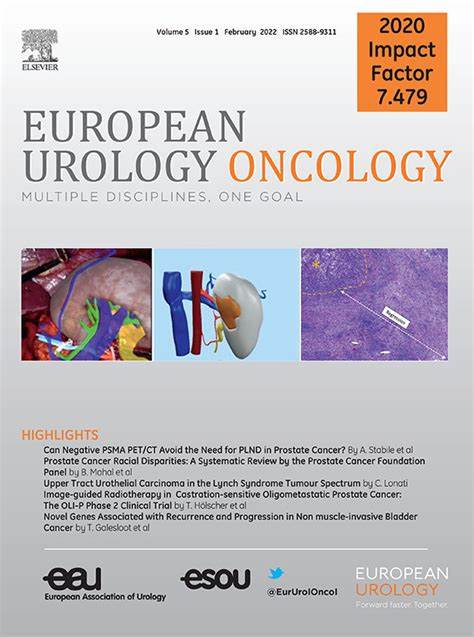Unmet Need in Non–muscle-invasive Bladder Cancer Failing Bacillus Calmette-Guérin Therapy: A Systematic Review and Cost-effectiveness Analyses from the International Bladder Cancer Group
IF 8.3
1区 医学
Q1 ONCOLOGY
引用次数: 0
Abstract
Background and objective
Non–muscle-invasive bladder cancer (NMIBC) poses a significant clinical challenge, particularly when failing bacillus Calmette-Guérin (BCG) therapy, necessitating alternative treatments. Despite radical cystectomy being the recommended treatment, many patients are unfit or unwilling to undergo this invasive procedure, highlighting the need for effective bladder-sparing therapies. This review aims to summarize and report the evidence on the efficacy and to estimate the costs of bladder-preserving strategies used in NMIBC recurrence after failure of intravesical BCG therapy.
Methods
We systematically searched online databases for prospective studies investigating intravesical therapy, systemic therapy, or combination of both in patients treated previously with BCG. Owing to significant heterogeneity across the studies, a meta-analysis was inappropriate. A sensitivity analysis was performed in an exploratory manner. We used a decision-analytic Markov model to compare novel U.S. Food and Drug Administration–approved treatments with a 2-yr time horizon.
Key findings and limitations
A total of 57 studies published between 1998 and 2024, with 68 unique study arms and consisting of 2589 patients, were identified. The 3-mo overall response rate (ORR) across all studies, complete response rate (CRR) in concomitant carcinoma in situ (CIS) or CIS only disease, and recurrence-free rate (RFR) in papillary disease were estimated to be 52.4% (95% confidence interval [CI]: 45.4–59.2), 52.8% (95% CI: 42.9–62.6), and 26.4% (95% CI: 13.3–45.6), respectively. The 12-mo ORR, CRR, and RFR were estimated to be 78% (95% CI: 52.9–91.8), 27.8% (95% CI: 21.3–35.4), and 25.4% (95% CI: 18.2–34.2), respectively. The progression rate was estimated to be 13% (95% CI: 9–18.2). The mean proportion of patients treated with radical cystectomy was estimated to be 24.7 (range 0–85.7). The reported toxicity grades were overall mild, with a median of 3.4% (range 0–33.3%) participants experiencing a dose limiting toxicity. Compared with using radical cystectomy to treat patients failing BCG therapy, at a willingness-to-pay threshold of 100 000 USD, nadofaragene firadenovec was cost effective, with an incremental cost-effectiveness ratio (ICER) of 10 014 USD per quality-adjusted life year (QALY), while nogapendekin alfa inbakicept was less cost effective than nadofaragene firadenovec (ICER of 44 602 USD per QALY). Pembrolizumab, which dominated, was both less costly and more effective than the other strategies.
Conclusions and clinical implications
Salvage bladder-sparing therapies show a response rate of around 50% at 3 mo in patients with NMIBC failing BCG. However, long-term data are heterogeneous. Nevertheless, recently developed agents show promising tumor control activity. In the rapidly evolving landscape of urothelial cancer, some of these treatment strategies might be cost effective and improve patients’ quality of life. The findings of our review highlight the need for novel, more effective therapeutic strategies.
Patient summary
In this study, we reviewed the evidence on the efficacy of bladder-preserving strategies used in patients with bladder cancer recurrence after failing bacillus Calmette-Guérin (BCG) therapy. We found that these strategies show a response rate of around 50% at 3 mo. However, long-term data are heterogeneous. Nevertheless, recently developed agents show promising tumor control activity. In the rapidly evolving landscape of urothelial cancer, some of these treatment strategies might be cost effective and improve patients’ quality of life.
卡介苗疗法失败的非肌层浸润性膀胱癌患者未满足的需求:国际膀胱癌小组的系统回顾和成本效益分析》。
背景和目的:非肌层浸润性膀胱癌(NMIBC)是一项重大的临床挑战,尤其是在卡介苗(BCG)治疗失败的情况下,需要采用替代疗法。尽管根治性膀胱切除术是推荐的治疗方法,但许多患者不适合或不愿意接受这种侵入性手术,这凸显了对有效保膀胱疗法的需求。本综述旨在总结和报告用于膀胱内卡介苗治疗失败后 NMIBC 复发的膀胱保留策略的疗效证据,并估算其成本:我们系统地检索了在线数据库,以了解对既往接受过卡介苗治疗的患者进行膀胱内治疗、全身治疗或两者结合治疗的前瞻性研究。由于各研究之间存在明显的异质性,因此不适合进行荟萃分析。我们以探索性的方式进行了敏感性分析。我们使用了一个决策分析马尔可夫模型来比较美国食品药品管理局批准的新型治疗方法,时间跨度为2年:我们共确定了 1998 年至 2024 年间发表的 57 项研究,其中有 68 个独特的研究臂,包括 2589 名患者。所有研究的3个月总反应率(ORR)、合并原位癌(CIS)或仅合并CIS疾病的完全反应率(CRR)以及乳头状疾病的无复发率(RFR)估计分别为52.4%(95%置信区间[CI]:45.4-59.2)、52.8%(95% CI:42.9-62.6)和26.4%(95% CI:13.3-45.6)。12个月的ORR、CRR和RFR估计分别为78%(95% CI:52.9-91.8)、27.8%(95% CI:21.3-35.4)和25.4%(95% CI:18.2-34.2)。进展率估计为 13%(95% CI:9-18.2)。接受根治性膀胱切除术的患者平均比例估计为 24.7(范围 0-85.7)。报告的毒性等级总体较轻,出现剂量限制性毒性的参与者中位数为 3.4%(范围 0-33.3%)。与使用根治性膀胱切除术治疗卡介苗治疗失败的患者相比,在100,000美元的支付意愿阈值下,纳多法拉基因firadenovec具有成本效益,每质量调整生命年(QALY)的增量成本效益比(ICER)为10,014美元,而诺加彭定康α-inbakicept的成本效益低于纳多法拉基因firadenovec(每质量调整生命年的ICER为44,602美元)。Pembrolizumab占主导地位,其成本和疗效均低于其他疗法:对于卡介苗治疗失败的 NMIBC 患者,挽救性膀胱保护疗法在 3 个月后的反应率约为 50%。然而,长期数据各不相同。不过,最近开发的药物显示出良好的肿瘤控制活性。在尿路上皮癌迅速发展的形势下,其中一些治疗策略可能具有成本效益,并能改善患者的生活质量。患者总结:在这项研究中,我们回顾了在卡介苗(BCG)治疗失败后膀胱癌复发患者中使用的保留膀胱策略的疗效证据。我们发现,这些策略在 3 个月后的反应率约为 50%。不过,最近开发的药物显示出良好的肿瘤控制活性。在尿路癌迅速发展的形势下,其中一些治疗策略可能具有成本效益,并能改善患者的生活质量。
本文章由计算机程序翻译,如有差异,请以英文原文为准。
求助全文
约1分钟内获得全文
求助全文
来源期刊

European urology oncology
Multiple-
CiteScore
15.50
自引率
2.40%
发文量
128
审稿时长
20 days
期刊介绍:
Journal Name: European Urology Oncology
Affiliation: Official Journal of the European Association of Urology
Focus:
First official publication of the EAU fully devoted to the study of genitourinary malignancies
Aims to deliver high-quality research
Content:
Includes original articles, opinion piece editorials, and invited reviews
Covers clinical, basic, and translational research
Publication Frequency: Six times a year in electronic format
 求助内容:
求助内容: 应助结果提醒方式:
应助结果提醒方式:


